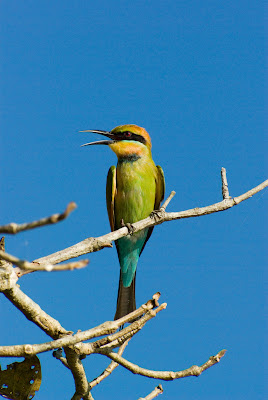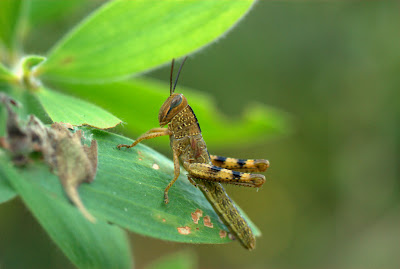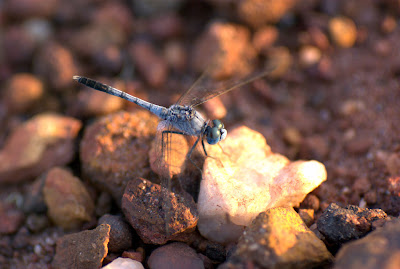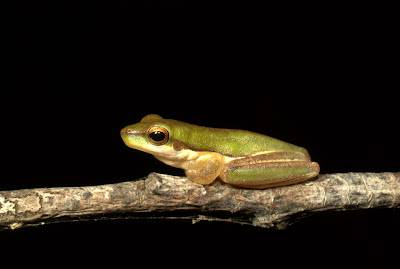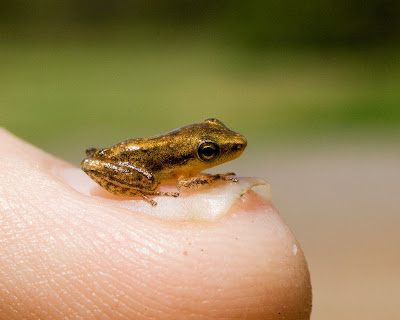There are plenty of animals out and about but I haven't been too active with the camera so far. The sight of these blue-triangle butterflies today inspired me to grab a photo.
Friday, December 14, 2007
Busy Buildup
There are plenty of animals out and about but I haven't been too active with the camera so far. The sight of these blue-triangle butterflies today inspired me to grab a photo.
Tuesday, November 13, 2007
Back in the Top End
As of about a week ago I've been back up in the Northern Territory. I'm up here to conduct my honours field work and will be returning south in mid-february.
It's nice to be re-acquainted with the heat, the storms, frogs, reptiles, plants and birds that I became used to during my last stay up here, though there are lots of other exciting things that I'm experiencing now that I didn't encounter then. The landscape has definitely changed in my absence and it's fascinating to see the biological changes that are driven by the seasons.
Below are a few photos from the last couple of days. Hopefully I'll keep the blog updated intermittently while I'm up here though I expect that as time goes on (and runs out) that I'll have few spare minutes to do so.

It's nice to be re-acquainted with the heat, the storms, frogs, reptiles, plants and birds that I became used to during my last stay up here, though there are lots of other exciting things that I'm experiencing now that I didn't encounter then. The landscape has definitely changed in my absence and it's fascinating to see the biological changes that are driven by the seasons.
Below are a few photos from the last couple of days. Hopefully I'll keep the blog updated intermittently while I'm up here though I expect that as time goes on (and runs out) that I'll have few spare minutes to do so.
Frill-Necked Lizard, Chlamydosaurus kingii.
Monday, October 22, 2007
Harlequin
Thursday, October 18, 2007
Mantispid
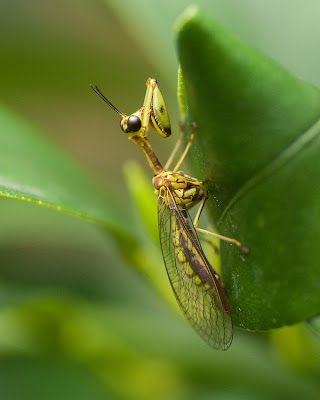 Just spotted this little insect in the garden. It's a mantispid or mantis-fly. I'd forgive you if, after a casual glance, you were to call it a mantid, however it actually belongs in an entirely different order - Neuroptera - which contains the lacewings. I was going to write more info on these critters however the annotated budak has already done so. So click the link to see another species and find out more.
Just spotted this little insect in the garden. It's a mantispid or mantis-fly. I'd forgive you if, after a casual glance, you were to call it a mantid, however it actually belongs in an entirely different order - Neuroptera - which contains the lacewings. I was going to write more info on these critters however the annotated budak has already done so. So click the link to see another species and find out more.
Monday, October 15, 2007
Another successful field trip
Had the weekend away up in the vicinity of Smith's Lake - I normally go up there a couple of times a year and spend some time frogging, herping, insecting, birding etc. and generally see at least something of note. The trip this time was particularly noteworthy for two quite interesting reptiles.

The first was this dragon - the southern forest or angle-headed dragon (Hypsilurus spinipes). I'd never seen one of these before so was stoked to discover it in a patch of rainforest. It's a species that can be quite hard to spot due to its good camouflague and arboreal habits, luckily this one was just at knee-height clinging to a small tree-trunk.
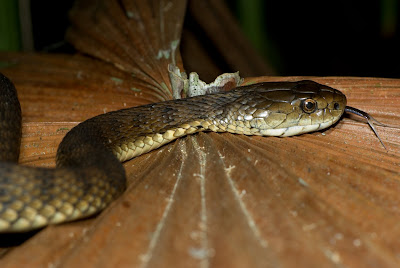
The second reptile of note was a rough-scaled snake (Tropidechis carinatus), another 'lifer'* for me. This snake is known to be very venomous and is known to have caused human mortalities. We came across this individual sitting on a palm-frond just beside a pond - it's likely that it was sitting in wait for a frog to hop past.

This is the red-eyed treefrog (Litoria chloris). Only when it rains a lot does this species suddenly appear, breed, and disappear again. I suspect it lives the majority of its life in the canopy. Luckily we had some good rain and a few individuals showed up despite the somewhat cool temperatures.

Photographed here is Litoria barringtonensis, one of the frogs in that confusing group of green stream frogs. The black spots distinguish this species from...
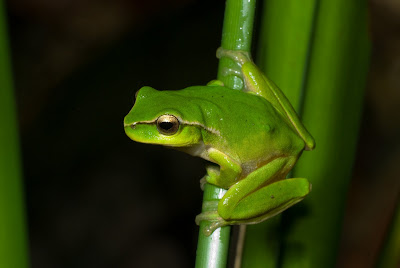
... Litoria phyllochroa. Interesting to get these two species together at the one site. Despite their similar appearance they do have distinctive calls.
 Finally, a photograph of a spawn mass of the tusked frog (Adelotus brevis). Unlike the more familiar spawn of Limnodynastes species, the eggs of Adelotus are entirely unpigmented.
Finally, a photograph of a spawn mass of the tusked frog (Adelotus brevis). Unlike the more familiar spawn of Limnodynastes species, the eggs of Adelotus are entirely unpigmented.
The first was this dragon - the southern forest or angle-headed dragon (Hypsilurus spinipes). I'd never seen one of these before so was stoked to discover it in a patch of rainforest. It's a species that can be quite hard to spot due to its good camouflague and arboreal habits, luckily this one was just at knee-height clinging to a small tree-trunk.

The second reptile of note was a rough-scaled snake (Tropidechis carinatus), another 'lifer'* for me. This snake is known to be very venomous and is known to have caused human mortalities. We came across this individual sitting on a palm-frond just beside a pond - it's likely that it was sitting in wait for a frog to hop past.

This is the red-eyed treefrog (Litoria chloris). Only when it rains a lot does this species suddenly appear, breed, and disappear again. I suspect it lives the majority of its life in the canopy. Luckily we had some good rain and a few individuals showed up despite the somewhat cool temperatures.

Photographed here is Litoria barringtonensis, one of the frogs in that confusing group of green stream frogs. The black spots distinguish this species from...

... Litoria phyllochroa. Interesting to get these two species together at the one site. Despite their similar appearance they do have distinctive calls.
Tuesday, October 09, 2007
Inside the hive
I got my colony of the native stingless bee Trigona carbonaria in late November last year. The housing for Trigona is two half-boxes on top of each other, (an optional small third box can be placed on top for honey), so when a colony is doing well it can be 'split' by separating the two boxes and placing them on corresponding empty boxes.
My colony was a 'split', so it was composed of a full bottom box and an empty top box and 'honey super' on top, and seemed to be going very strong from the activity around the entrance. So, I thought I'd take the honey box off and see how the inner workings of the hive were going. Here are some photos from the event.
This is the main cavity of the box - you can see that it's nearly full of brood (the spiral structure up the top of the photo), pollen and nectar pots. Close-ups to follow.
This is the 'honey super' which sits on top. The piece of board in the photo below sits between this and the rest of the box cavity with small spaces at each end - the idea is that the brood spiral doesn't extend into the honey box, but honey and pollen are stored here, so the honey can be harvested without damaging the brood.
Divider board with amazing wax structure.
The spiral brood. Each little pot, when sealed, contains an egg or larva and enough supplies for it to develop into an adult. You can see some of the pots around the edges are open, still being stocked or waiting for the queen to oviposit.
Looks like the colony's doing very well - I expect they will stock the honey super more in the coming months, and it will be ready for a split before too long.
Thursday, September 20, 2007
Update... Pectinate...
Okay, it's been a shockingly long time since updates of any regularity. I've been back down here in (cold) Sydney since early July, starting honours. I'll be heading up to the top end again in about a month for honours field-work. Coming back mid-February, writing up for about a month, then I'll be free. Now that will feel weird!
As for the future of this blog... well for now I don't see any point in shutting it down despite the fact that posts are likely to be rather infrequent. We'll see what happens.
Got a photo published in the Sydney Morning Herald recently, thanks to my supervisor.
Had a photo used in a recent publication - remember that big beautiful mite, well turns out that similar looking things were around in the Early Cretaceous.
Dunlop J. A. (2007) A large parasitengonid mite (Acari, Erythraeoidea) from the Early Cretaceous Crato Formation of Brazil. Fossil Record 10, 91-8. doi: 10.1002/mmng.200700001
Took the camera out a couple of days ago, it's been hibernating since being back in Sydney. Snapped this shot of a beetle's antennae. Not a technically great photo but I thought I'd share it anyway as the structure ('pectinate' meaning comb-shaped) is quite impressive.
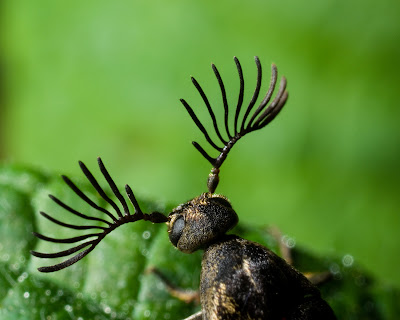
As for the future of this blog... well for now I don't see any point in shutting it down despite the fact that posts are likely to be rather infrequent. We'll see what happens.
Got a photo published in the Sydney Morning Herald recently, thanks to my supervisor.
Had a photo used in a recent publication - remember that big beautiful mite, well turns out that similar looking things were around in the Early Cretaceous.
Dunlop J. A. (2007) A large parasitengonid mite (Acari, Erythraeoidea) from the Early Cretaceous Crato Formation of Brazil. Fossil Record 10, 91-8. doi: 10.1002/mmng.200700001
Took the camera out a couple of days ago, it's been hibernating since being back in Sydney. Snapped this shot of a beetle's antennae. Not a technically great photo but I thought I'd share it anyway as the structure ('pectinate' meaning comb-shaped) is quite impressive.

Monday, June 25, 2007
Fire!
Just thought this one taken tonight by the side of the road was apt, following the previous post on Macrozamias resprouting.
Tuesday, June 19, 2007
Assorted
A biting fly was annoying me as I walked along a fenceline a couple of weeks ago. I paused to photograph this Nephila and the fly blundered into the web! Bonus! You can see that the spider was actually already eating something.
Sunday, June 17, 2007
Macrozamias - Fire - Regrowth
It seems like fire is a huge ecological force everywhere in Australia, and the Top End is no exception. You can imagine how the massive amounts of vegetation generated in the wet season can lead to huge fuel loads and intense fires. The question up here is the same as it is in Sydney where I'm from - how often should areas be burnt to maintain biodiversity? I don't know enough about this topic to discuss it intelligently, but it's definitely something that it's not easy to forget as smoke fills the air on a daily basis and roadside fires are a common sight.
One such roadside fire was burning a few weeks ago, and the flora has shown its ability to regenerate with great enthusiasm. The plants that really catch my eye are the cycads - Macrozamias. So without further ado, here is a series of photos illustrating the regrowth of these plants.
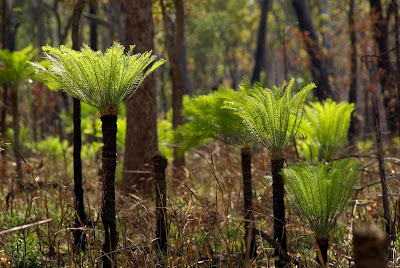




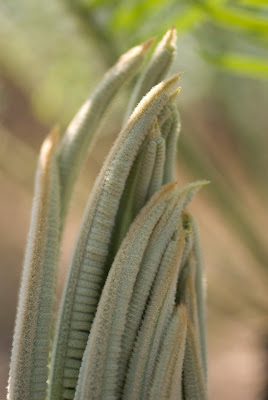

One such roadside fire was burning a few weeks ago, and the flora has shown its ability to regenerate with great enthusiasm. The plants that really catch my eye are the cycads - Macrozamias. So without further ado, here is a series of photos illustrating the regrowth of these plants.







Tuesday, May 22, 2007
New camera - new photos!
Monday, May 21, 2007
Bizzare File Snakes and the Runoff
As the water recedes, many aquatic organisms risk becoming trapped, and desperately try to travel upstream to permanent water. At a nearby creek, just such an event has been occurring recently. In addition to the millions of fish, shrimp and crayfish, the most exciting inhabitants of the waterway are the entirely aquatic file snakes occurring there in amazing numbers, trying to cross the culvert under the road where the water flows swiftly.
Trivia: they're supposedly quite a tasty dish in indigenous culture!
Saturday, May 12, 2007
Litoria dahlii, Dahl's Aquatic Frog
 Visitors to Fogg Dam that know a bit about herps generally try to see two animals that are almost icons of the place. One of these is the Water Python, Liasis mackloti. These snakes occur at incredibly high densities in the floodplains of this region, feasting on the staggeringly abundant Dusky Rats (Rattus colletti). The biomass of these two species is said to exceed that of an equal area of the Serengeti plains. But I digress.
Visitors to Fogg Dam that know a bit about herps generally try to see two animals that are almost icons of the place. One of these is the Water Python, Liasis mackloti. These snakes occur at incredibly high densities in the floodplains of this region, feasting on the staggeringly abundant Dusky Rats (Rattus colletti). The biomass of these two species is said to exceed that of an equal area of the Serengeti plains. But I digress.The other animal that this area is 'famous' for is the subject of this post, Litoria dahlii, Dahl's Aquatic Frog. Again, this species is one of the most conspicuous animals of the floodplains. On wet nights the Arnhem Highway can be absolutely covered in them. To me, this frog is one of the more interesting in the area, there are some aspects of its ecology that are quite unique.
 But firstly, who was Dahl? A bit of googling turned up a Knut Dahl, a native of Norway, who did some exploring and collecting in this part of Australia, including Arnhem land, in the late 19th century. Not sure of his connection to the species' describer, George Boulenger (who seems to have been quite a clever character), though I suppose that it's possible Knut was the collector of the species.
But firstly, who was Dahl? A bit of googling turned up a Knut Dahl, a native of Norway, who did some exploring and collecting in this part of Australia, including Arnhem land, in the late 19th century. Not sure of his connection to the species' describer, George Boulenger (who seems to have been quite a clever character), though I suppose that it's possible Knut was the collector of the species.The other part of this species' common name is also quite correct; one of the peculiar things about this species is that it's largely aquatic. Although they do seem to travel considerable distances over land by night, their main place of habitation tends to be in water around the edges of dams and ponds, where they are often spotted clinging to or sitting on top of aquatic vegetation such as lilly pads or algal mats on the surface. Their aquatic nature goes further - they are one of the few species of frog in Australia that are known to feed on underwater items. I've seen them eat things whilst both they and their prey are floating on the surface by lunging forward by means of a thrust of those back legs with their webbed toes.
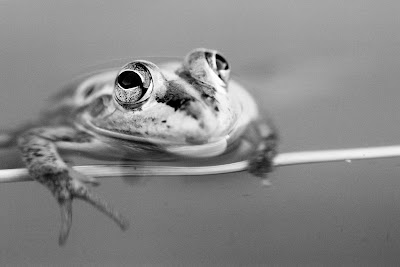 You might recognise some similarities to other Australian frogs - the 'complex' of frogs that this species belongs to is the Bell Frogs, containing things like Sydney's endangered Green and Golden Bell frog (Litoria aurea) and the Motorbike frog of WA (Litoria moorei). All the frogs in this rough group seem to be rather aquatic, though if I'm not mistaken L. dahlii is the most so. A further trait of the group is some daytime activity, and this is true of L. dahlii too - I've seen them basking in the afternoon sun out at Fogg dam.
You might recognise some similarities to other Australian frogs - the 'complex' of frogs that this species belongs to is the Bell Frogs, containing things like Sydney's endangered Green and Golden Bell frog (Litoria aurea) and the Motorbike frog of WA (Litoria moorei). All the frogs in this rough group seem to be rather aquatic, though if I'm not mistaken L. dahlii is the most so. A further trait of the group is some daytime activity, and this is true of L. dahlii too - I've seen them basking in the afternoon sun out at Fogg dam.Another interesting thing about the species is its diet. The menu includes frogs, either of the same species or another. At places where the species is abundant, the scream of a young frog as it's eaten by a larger individual is a sound that may be heard occasionally. I suspect that small fish are taken as they doze in the shallows at night. Tadpoles are definitely eaten too. There's even an account in the literature of a frog trying to eat a roadkilled death adder! That's one reference I'll have to try to track down!
Apologies for the nearly month-long absence of posts, I'll try to post something else tomorrow!
Thursday, April 19, 2007
Saturday, April 14, 2007
The definition of cute...
Thursday, April 12, 2007
Snake vs Frog Round II
As I was traipsing along a bush track the other day, a young Roth's Treefrog (Litoria rothii) suddenly leapt out from beside the track, with a Golden Tree-snake (Dendrelaphis punctulata) in hot pursuit. They both noticed me in the same instant and the three of us froze - the frog halted its hopping, the snake slid to a stop just past the frog (which was superbly camoflagued against the sand), my hand reaching for the camera being my only movement.
The snake regained its composure, and began tongue-flicking and moving its head backwards, forwards and side-to-side, trying to pick up the scent of its quarry. The frog remained petrified, but to no avail. The snake closed in, spotted the frog, and quickly struck.
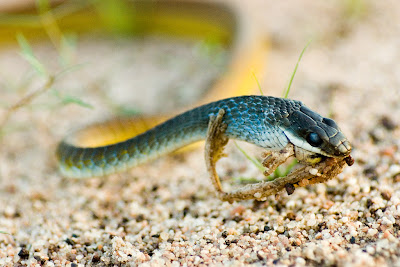
The consumption of this frog was much faster than the last one I witnessed, a mere mouthful to the snake. Interestingly, you can see from the photos that this snake has something wrong with its eye - it's dark and clouded and I suspect it could not see out of this eye very well, if at all. Indeed, as I moved around to the other side of the snake for a photo of its good eye, it suddenly realised I was there and made haste into the bush.
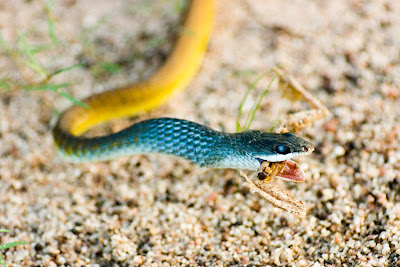
Both of these animals are largely tree-dwelling, and it's my guess that the snake, upon coming across the frog in a tree or pandanus, then had to pursue it after it jumped to the ground.
Something tells me it's not really a fair fight...
The snake regained its composure, and began tongue-flicking and moving its head backwards, forwards and side-to-side, trying to pick up the scent of its quarry. The frog remained petrified, but to no avail. The snake closed in, spotted the frog, and quickly struck.

The consumption of this frog was much faster than the last one I witnessed, a mere mouthful to the snake. Interestingly, you can see from the photos that this snake has something wrong with its eye - it's dark and clouded and I suspect it could not see out of this eye very well, if at all. Indeed, as I moved around to the other side of the snake for a photo of its good eye, it suddenly realised I was there and made haste into the bush.

Both of these animals are largely tree-dwelling, and it's my guess that the snake, upon coming across the frog in a tree or pandanus, then had to pursue it after it jumped to the ground.
Something tells me it's not really a fair fight...
Friday, April 06, 2007
Afternoon of dragonflies
Set out towards Fogg Dam tonight with the camera and the intention to take some photos. Ended up shooting nothing but dragonflies, as the light faded (so depth of field and shutter-speed were real issues).
Got a couple of keepers, thought they made a nice little series. Dragonflies are in incredible abundance up here. But then, everything is!
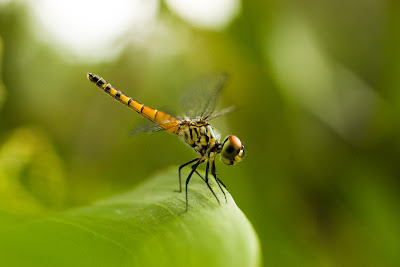
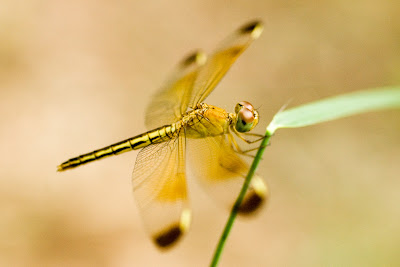

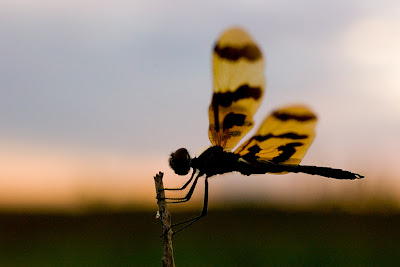
Got a couple of keepers, thought they made a nice little series. Dragonflies are in incredible abundance up here. But then, everything is!




Subscribe to:
Posts (Atom)





